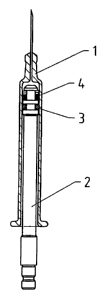Some of the information on this Web page has been provided by external sources. The Government of Canada is not responsible for the accuracy, reliability or currency of the information supplied by external sources. Users wishing to rely upon this information should consult directly with the source of the information. Content provided by external sources is not subject to official languages, privacy and accessibility requirements.
Any discrepancies in the text and image of the Claims and Abstract are due to differing posting times. Text of the Claims and Abstract are posted:
| (12) Patent: | (11) CA 2314206 |
|---|---|
| (54) English Title: | A PROCESS FOR COATING PRIMARY PRODUCTS AND A DEVICE FOR CARRYING OUT THE PROCESS |
| (54) French Title: | PROCEDE D'ENROBAGE DE PRODUITS PRIMAIRES ET DISPOSITIF FAISANT APPEL A CE PROCEDE |
| Status: | Deemed expired |
| (51) International Patent Classification (IPC): |
|
|---|---|
| (72) Inventors : |
|
| (73) Owners : |
|
| (71) Applicants : |
|
| (74) Agent: | KIRBY EADES GALE BAKER |
| (74) Associate agent: | |
| (45) Issued: | 2006-07-04 |
| (22) Filed Date: | 2000-07-21 |
| (41) Open to Public Inspection: | 2001-01-24 |
| Examination requested: | 2000-09-26 |
| Availability of licence: | N/A |
| (25) Language of filing: | English |
| Patent Cooperation Treaty (PCT): | No |
|---|
| (30) Application Priority Data: | ||||||
|---|---|---|---|---|---|---|
|
The invention provides a process and a device for coating the inside of syringe barrels (1) of little volume with a silicone film. A coating ring (3) is moistened with silicone oil, the coating ring (3) is then inserted in the syringe barrel (1) and guided axially along the inside wall. During this process, the coating ring (3) completely abuts against the inside wall. When the coating ring (3) is finally withdrawn, a wiper ring (4) located behind it in the direction of motion removes the excess silicone oil, thereby creating a homogeneous silicone film of even thickness. In a preferred embodiment, the coating ring (3) and the wiper ring (4) are both arranged on a siliconizing mandrel (2) at an axial distance from each other, whereby the siliconizing mandrel (2) has a channel (5) in axial direction for feeding the silicone oil. Its one end opens into the area of the coating ring (3), whilst its other end is arranged in such a way that it can be connected to a feeder tube (6).
Cette invention fournit un processus et un dispositif pour enduire l'intérieur de boîtes de seringues (1) de petit volume avec une pellicule en silicone. Un anneau d'enduit (3) est humidifié avec de l'huile de silicone, l'anneau d'enduit (3) est ensuite placé à l'intérieur de la boîte à seringues (1) et dirigé de manière axiale le long du mur intérieur. Au cours du processus, l'anneau d'enduit (3) est plaqué contre le mur intérieur. Lorsque l'anneau d'enduit (3) est retiré, une lingette (4) située derrière l'anneau d'enduit est activée pour retirer l'excès d'huile de silicone, ce qui permet de créer une pellicule en silicone homogène d'une épaisseur régulière. Idéalement, l'anneau d'enduit (3) et la lingette (4) sont placés sur le mandrin de silicone (2) à une distance axiale, le mandrin de silicone (2) est doté d'un canal (5) en direction axiale pour alimenter l'huile de silicone. Il révèle une zone de l'anneau d'enduit (3), tandis que l'autre extrémité est placée de manière à être connectée à un tuyau d'alimentation (6).
Note: Claims are shown in the official language in which they were submitted.
Note: Descriptions are shown in the official language in which they were submitted.

For a clearer understanding of the status of the application/patent presented on this page, the site Disclaimer , as well as the definitions for Patent , Administrative Status , Maintenance Fee and Payment History should be consulted.
| Title | Date |
|---|---|
| Forecasted Issue Date | 2006-07-04 |
| (22) Filed | 2000-07-21 |
| Examination Requested | 2000-09-26 |
| (41) Open to Public Inspection | 2001-01-24 |
| (45) Issued | 2006-07-04 |
| Deemed Expired | 2014-07-22 |
There is no abandonment history.
| Fee Type | Anniversary Year | Due Date | Amount Paid | Paid Date |
|---|---|---|---|---|
| Registration of a document - section 124 | $100.00 | 2000-07-21 | ||
| Application Fee | $300.00 | 2000-07-21 | ||
| Request for Examination | $400.00 | 2000-09-26 | ||
| Maintenance Fee - Application - New Act | 2 | 2002-07-22 | $100.00 | 2002-05-08 |
| Maintenance Fee - Application - New Act | 3 | 2003-07-21 | $100.00 | 2003-04-29 |
| Maintenance Fee - Application - New Act | 4 | 2004-07-21 | $100.00 | 2004-04-28 |
| Maintenance Fee - Application - New Act | 5 | 2005-07-21 | $200.00 | 2005-05-13 |
| Final Fee | $300.00 | 2006-04-10 | ||
| Maintenance Fee - Application - New Act | 6 | 2006-07-21 | $200.00 | 2006-04-26 |
| Maintenance Fee - Patent - New Act | 7 | 2007-07-23 | $200.00 | 2007-04-16 |
| Maintenance Fee - Patent - New Act | 8 | 2008-07-21 | $200.00 | 2008-05-14 |
| Maintenance Fee - Patent - New Act | 9 | 2009-07-21 | $200.00 | 2009-07-06 |
| Maintenance Fee - Patent - New Act | 10 | 2010-07-21 | $250.00 | 2010-04-15 |
| Maintenance Fee - Patent - New Act | 11 | 2011-07-21 | $250.00 | 2011-04-01 |
| Maintenance Fee - Patent - New Act | 12 | 2012-07-23 | $250.00 | 2012-04-12 |
Note: Records showing the ownership history in alphabetical order.
| Current Owners on Record |
|---|
| ARZNEIMITTEL GMBH APOTHEKER VETTER & CO. RAVENSBURG |
| Past Owners on Record |
|---|
| VETTER, UDO J. |